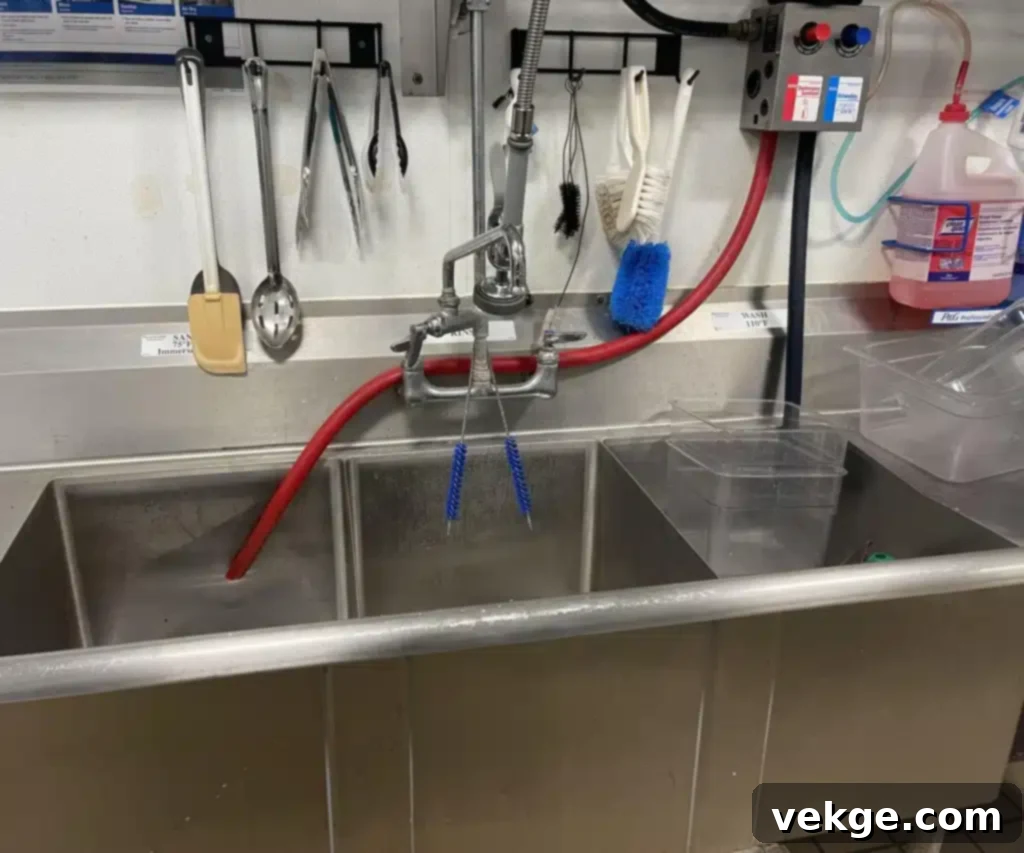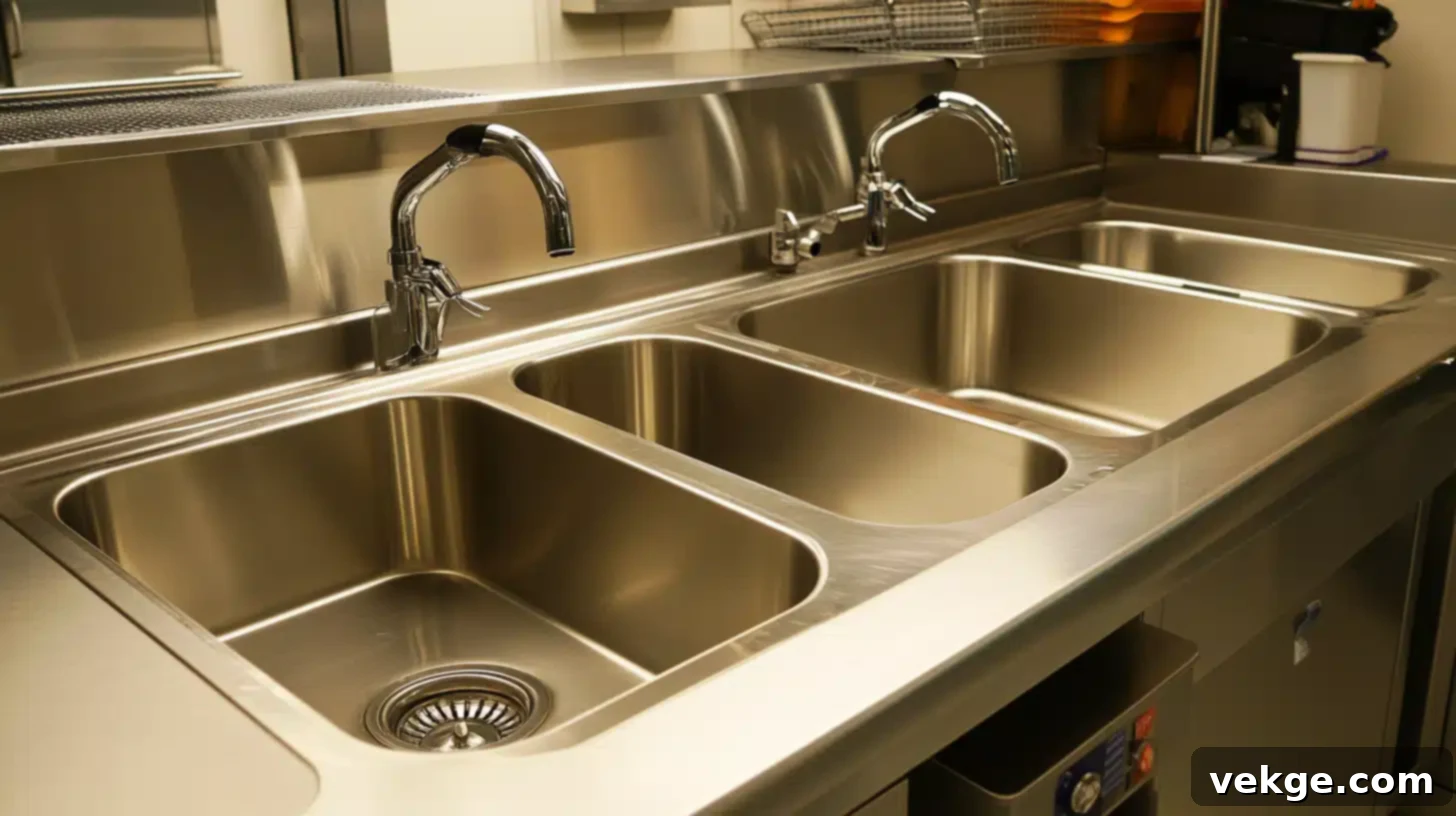The Ultimate Guide to Commercial Stainless Steel 3-Compartment Sinks: Durability, Hygiene & Selection
In the dynamic world of commercial kitchens, where efficiency, hygiene, and durability are paramount, the choice of equipment plays a critical role. Among the foundational elements, stainless steel kitchen equipment stands out as the industry standard. This broad category encompasses a wide array of components, from robust worktops and industrial-grade cabinets to shelving units and, most notably, commercial sinks. Renowned for its exceptional strength, longevity, and resistance to corrosion, stainless steel is the material of choice for professional environments that demand uncompromising performance.
Within this essential category, stainless steel sinks hold a particularly vital position. Their ability to blend functionality with a pristine appearance makes them indispensable. Among the various types, the commercial 3-compartment stainless steel sink is a cornerstone in almost every foodservice establishment. Its design is not merely for convenience but is deeply rooted in strict health and safety regulations, requiring a specific sequence for washing, rinsing, and sanitizing dishes and utensils. This dedicated setup ensures that kitchenware meets the highest standards of cleanliness, preventing the spread of foodborne illnesses and maintaining a hygienic operation.
Understanding the Indispensable Role of Commercial 3-Compartment Sinks

Commercial 3-compartment sinks are much more than just a place to wash dishes; they are a strategic investment in the smooth, safe, and efficient operation of any professional kitchen. Their design, featuring three distinct basins, directly facilitates the critical “wash, rinse, sanitize” procedure mandated by health departments worldwide. This systematic approach ensures that all dishware, cookware, and utensils are thoroughly cleaned and disinfected, eliminating contaminants and promoting a safe dining experience for customers.
Beyond their compliance with health regulations, these sinks are engineered for extreme resilience. Even in the most demanding, high-volume kitchen environments, characterized by constant activity, noise, and potential impacts, commercial 3-bay sinks maintain their structural integrity and aesthetic appeal. Stainless steel’s inherent properties make these sinks remarkably resistant to rust, corrosion, and staining. This allows them to withstand continuous exposure to water, harsh detergents, acidic food spills, and various chemicals without degrading, discoloring, or compromising their performance. This exceptional durability translates into a longer lifespan for the equipment, reducing the need for frequent replacements and saving businesses significant costs over time.
Furthermore, the practical benefits extend to ease of maintenance. A stainless steel 3-compartment sink requires minimal effort to keep it sparkling clean. Unlike other materials that might demand specialized cleaners or rigorous scrubbing to remove stains and buildup, stainless steel typically responds well to simple cleaning solutions. A quick wipe down with a little dish soap and warm water is often all that’s needed to restore its lustrous finish. Its non-porous surface not only prevents stains from taking hold but also inhibits the growth of bacteria and other microorganisms, making it an inherently hygienic choice for food preparation areas. This low-maintenance aspect is crucial for busy commercial kitchens where time is a precious commodity, allowing staff to focus on food preparation and service rather than extensive cleaning routines.
Making the Right Choice: Key Considerations for Your 3-Compartment Sink
Selecting the ideal 3-compartment sink for your commercial kitchen goes beyond simply choosing stainless steel. A well-informed decision will ensure the sink perfectly meets your operational needs, enhances efficiency, and provides long-term value. Several critical factors should be carefully evaluated:
Bowl Dimensions and Configuration
The size and shape of the individual bowls are paramount. Consider the largest items you will routinely wash, such as oversized pots, pans, or baking sheets. A rectangular bowl, for instance, typically offers more usable space than a square one, making it easier to maneuver larger items or accommodate more dishes at once. The drop depth of each basin is equally significant. Deeper sinks are invaluable for preventing splashes, accommodating taller utensils, or allowing for more extended soaking of heavily soiled items. Measure your typical cookware and dishware to ensure the chosen sink’s dimensions are genuinely practical for your kitchen’s specific demands.
Steel Gauge and Finish
The gauge of the stainless steel refers to its thickness; a lower gauge number indicates thicker, more robust steel. For high-volume commercial use, a lower gauge (e.g., 14 or 16 gauge) is highly recommended. Thicker steel provides superior resistance to dents, impacts, and warping, ensuring the sink can withstand the rigors of a busy kitchen without compromise. While 18 gauge might be suitable for lighter use, 14 or 16 gauge offers the resilience needed for heavy-duty applications. The finish of the stainless steel also plays a role, with brushed finishes being common for commercial sinks due to their ability to hide minor scratches and maintain a professional appearance.
Integrated Features and Design
Beyond the basic three compartments, many commercial sinks come with additional features that can significantly enhance functionality. Drainboards, positioned to the left, right, or both sides of the basins, provide essential space for air-drying dishes, stacking clean items, or preparing food. A longer drainboard can be particularly beneficial for kitchens with high dishwashing volume. Backsplashes are another critical feature, protecting adjacent walls from splashes and spills, thereby simplifying cleanup and maintaining hygiene. Adjustable legs are also a practical consideration, allowing staff to set the sink at a comfortable working height and ensuring stability on uneven floors. Finally, always look for products that are NSF certified. NSF International is a public health and safety organization that certifies products meet rigorous standards for public health protection, ensuring the sink is designed and constructed in a way that is easy to clean and sanitize.
Best Practices for Maintaining Your Restaurant’s 3-Compartment Sink
Proper and consistent maintenance is key to extending the life of your commercial 3-compartment sink, preserving its hygienic properties, and ensuring efficient operation. Implementing a routine cleaning schedule can prevent common issues and keep your kitchen running smoothly.
Firstly, ensure that each compartment is always equipped with access to hot water and appropriate cleaning agents. Even low-use commercial stainless steel 3-compartment sinks benefit from regular flushing; running hot water through them a few times a week helps to eliminate stagnant odors and reduces the likelihood of drain lines drying up and accumulating residue. This simple habit can prevent more significant problems down the line.
At the close of each shift or business day, staff members should thoroughly clean every sink drain. Food particles, grease, and other debris can accumulate rapidly, creating ideal breeding grounds for mold, mildew, and fruit flies. To effectively combat this, every commercial dishwashing station should be cleaned with a bio-enzymatic cleaner or a specialized drain sanitizer. These products break down organic matter, preventing clogs and neutralizing odors more effectively than standard cleaners. Consistency in this daily routine is paramount for maintaining a clean and pest-free environment.
To further safeguard your plumbing system, install straining devices, such as fine mesh colanders, in 3-compartment sinks that frequently collect food material. These devices act as a first line of defense, catching larger food scraps before they can enter and potentially clog the pipes. Emphasize to staff members the importance of never allowing food scraps, garnishes, or any solid waste to go down the side of the stainless steel 3-compartment sink. Not only can this lead to severe blockages, but trapped food waste also serves as a haven for fruit flies and other pests, compromising kitchen hygiene.
Beyond daily cleaning, avoid using harsh abrasive scrubbers or steel wool, as these can scratch the surface of stainless steel and compromise its protective layer, making it more susceptible to corrosion. Similarly, strong chemical cleaners containing bleach or chlorides should be used with caution, as prolonged exposure can pit and stain the steel. Opt for mild detergents and stainless steel-specific cleaners to maintain the finish and integrity of your sink for years to come.
Decoding Stainless Steel Grades: Why Quality Matters for Commercial Sinks
The term “stainless steel” isn’t monolithic; it encompasses various alloys, each with distinct properties. These variations primarily stem from differences in their crystalline structure and elemental composition, which, in turn, dictate their durability, corrosion resistance, and magnetic properties. Understanding the grades is crucial for making an informed investment in commercial kitchen equipment.
Stainless Steel Grade 430: Understanding Its Limitations
Grade 430 stainless steel is a ferritic alloy, which means it contains chromium but lacks the nickel found in higher-grade steels. Its primary advantage is its lower cost, making it an attractive option for budget-conscious consumers. Characteristically, 430 stainless steel is nearly as magnetic as regular steel. While it offers some corrosion resistance, it is significantly less robust than other grades. Its susceptibility to rust and discoloration is higher, particularly when exposed to moisture, acidic foods, or harsh cleaning agents over time. To extend its lifespan, it demands meticulous and consistent drying and cleaning, especially in humid environments. For the demanding, wet, and often aggressive chemical-filled environment of commercial kitchen sinks, Grade 430 is generally NOT RECOMMENDED. Its limitations could lead to premature degradation, costly replacements, and potential health code violations.
Stainless Steel Grade 304: The Industry Standard for Commercial Sinks
Grade 304 stainless steel is an austenitic alloy, distinguished by its higher chromium and nickel content. This composition is precisely what gives it its superior qualities, making it the industry benchmark and the unequivocal recommendation for commercial kitchen sinks. While it comes at a higher price point than 430, the investment is justified by its unparalleled performance and longevity. Grade 304 is almost entirely resistant to corrosion, rust, and staining, even when exposed to a wide range of chemicals, food acids, and high humidity levels. It tidies up effortlessly, maintaining its pristine appearance with minimal upkeep. Unlike 430, 304 stainless steel is non-magnetic, a property often used as a quick indicator of its quality. For facilities located near the coast or in exceptionally humid areas, where corrosion is an even greater concern, using entirely 304-grade stainless steel equipment is not just a recommendation but a necessity to ensure maximum lifespan and hygienic standards.
Investing in Longevity and Efficiency
In conclusion, the decision to equip your commercial kitchen with high-quality stainless steel 3-compartment sinks is an investment in the longevity, efficiency, and hygiene of your entire operation. By understanding the critical factors involved in selection—from bowl dimensions and steel gauge to integrated features and, most importantly, the distinction between stainless steel grades—you can make an informed choice that will pay dividends for years to come. Opting for the superior durability and corrosion resistance of 304-grade stainless steel, coupled with diligent maintenance, ensures that your kitchen remains a safe, productive, and compliant environment. Choose wisely, and your commercial sinks will serve as a reliable workhorse, underpinning the success of your culinary endeavors.
